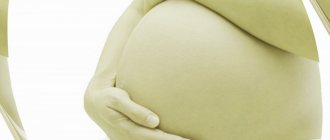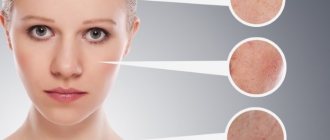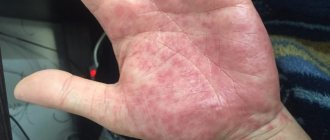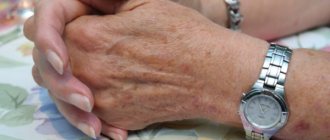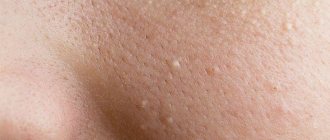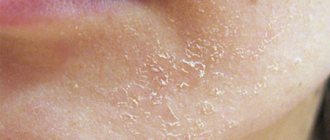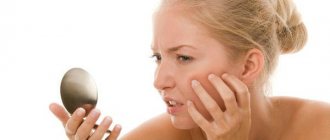Skin is the largest human organ, which is a kind of indicator of health, a barrier against various types of infections. But it is she who, most often, is the first to react to problems in the body, showing that something is wrong with health. Any inflammatory processes on a child’s skin, especially in the form of red spots, are a symptom that parents should not ignore.
The article will discuss the most likely causes of the rash with photos and descriptions, so that every mother can distinguish allergies from possible serious diseases.
Red spots like bites
Red spots on a child’s body can be not only bites, but also an allergic rash :
- Prickly heat. Small, light pink pimples located close to each other. The rash is localized in the upper chest, neck and shoulders . First of all, it is important to maintain hygiene. During the hot period, water procedures are carried out in decoctions of chamomile and string. Baby powder will help remove excess moisture; you should not lubricate the skin with cream - a humid environment will provoke the appearance of new pimples.
- Hives are often confused with mosquito bites - these are pink blisters that cause severe itching. When scratched, a bloody crust forms on them. Infections, physical irritants or allergies provoke the development of hives. For urticaria, the affected areas are treated with powder. Antihistamines are used in the treatment of mild forms: Zyrtec, Claritin, Telfast. The use of enterosorbents (activated carbon) has a positive effect. Use prednisolone ointment, Deperzolon or water-zinc pastes with 2-3% naftalan oil.
- Insect bites. Exposed areas of the body are covered with tubercles and red spots. The child is bothered by severe itching, but the general condition does not change. Wounds (not bloody) are lubricated with brilliant green to avoid bacterial infection. Lotions made from soda solution help relieve itching.
The insect rash goes away within a week; if this does not happen, the child should be shown to a dermatologist.
Extensive spots on the body. What could it be, what should I do?
There are quite a few reasons why red spots may appear on a child’s body. A photo with a description of the disease allows you to clearly see the characteristic differences between one pathology and another.
Causes:
- Erythema begins with small dots appearing on the face, later merging into large spots and spreading throughout the body. This is a natural skin condition caused by excess blood flow to the capillaries. The cause may be poor circulation, allergic reactions, chemical or sunburn. The rash does not require treatment; it will go away on its own within 2 weeks and does not cause discomfort.
- Hives may be accompanied by small or large blistering spots. A rash of allergic origin is triggered by food, infectious diseases, and hormonal disorders. Children are prescribed medications that soothe itching and strengthen the immune system. Cool vinegar compresses (1 tablespoon per glass of water) eliminate the burning sensation;
- Infantile roseola. The child suffers from fever for 3-5 days, after which a bright, small, and in rare cases extensive rash appears on the skin. The most serious complications are limited to febrile seizures. The spots cannot be felt by touch; some elements are surrounded by white rings. The rash is localized on the chest, rarely reaching the face and limbs. Treatment consists of bed rest, drinking plenty of fluids, and taking fever-reducing medications.
- Pityriasis rosea. Judging by the photo with the description, such red spots on a child’s body can reach very large sizes. Large round or oval plaques appear on the patient's body. The spots are localized on the abdomen, chest, thighs, and there is slight peeling in the center of the lesion. At the same time, there is an increase in temperature, enlarged lymph nodes, and general malaise. The child is recommended to have a hypoallergenic diet and take antihistamines to relieve itching.
Why do red spots appear on the face?
To accurately determine the reason why focal redness may appear in different areas of the face, you need to carefully study their characteristics: size, location, additional symptoms (whether they begin to itch or peel, whether they differ in relief), try to remember when they formed. Factors that contribute to the appearance of red areas can be divided into several groups:
- the result of using masks with locally irritating components, or procedures for eliminating blackheads, chemical peeling;
- the consequences of rosacea and other large rashes (even small acne and single boils can be included here), which, after disappearing, leave red spots that are difficult to remove with cosmetic procedures;
- allergies (including reactions to the sun, cold, etc.);
- symptom of skin diseases (allergic dermatitis, lupus, eczema, etc.);
- closely spaced blood vessels (mostly these are spots already observed on the face of a newborn baby);
- hormonal imbalances;
- lack of vitamins;
- diseases of the gastrointestinal tract;
- reaction to taking medications;
- increased blood circulation after exercise, nervous tension, pressure surge.
If, when large flat spots of a red tint appear on your face, you do not feel itching, do not experience a burning sensation and notice the problem only in the mirror, or when you touch it (due to peeling), this may be an allergic reaction. Mostly red spots on the face are formed when there is an allergy to cold or sunlight, and to eliminate them you only need to get rid of the provoking agent. However, this may be a sign of an autoimmune disease - the same symptoms (even in the photo they are similar) are used to identify lupus erythematosus.
- Red spots on the head in a child and an adult
- Causes of red cheeks in adults and children - how to get rid of them with medicines and folk remedies
- Why does my face burn and become very red?
We suggest you read How to make a bruise on your face without pain
In men
High physical activity, visiting baths and saunas, or staying in a hot climate are the most common reasons why a man's face is covered with red spots localized in the cheeks and lips. This will be accompanied by sweat, shortness of breath, and a change in body temperature. However, if after exposure to cool air and a slower pulse the symptom does not go away, the spots appear in any conditions, we can assume:
- hypertension;
- heart diseases;
- eczema.
Among women
Hormonal disruptions, even situational ones (during the menstrual cycle), become a common cause of skin rashes: small pimples, areas of peeling and redness appear on the face, which may disappear after the end of menstruation, or may remain. Mostly such spots do not itch and do not cause any particular discomfort, but if they accompany each cycle or are observed throughout pregnancy (large areas - cheeks, chin), it is worth seeing an endocrinologist.
The child has
Small children (especially infants) do not have strong immunity, so every second young mother worries about allergic rashes and red spots that appear on the child’s face. They can be the body’s reactions to literally anything - among the reasons that contribute to the appearance of redness are:
- change in climatic conditions;
- new products on the menu;
- birth injuries;
- infections;
- allergy to insect bites;
- problems with the functioning of the gastrointestinal tract.
A couple of additional symptoms that accompany irritation on the face in the form of red spots are often a sign of a skin disease. Several problems can be expected:
- psoriasis;
- eczema;
- demodicosis (subcutaneous mite);
- viral type lichen;
- Rosacea.
Less commonly, redness, which is accompanied by peeling, can be attributed to a sun allergy, or, if severe itching is present, to a burn, but here a new symptom will be added - pain when touching the spot. Regarding the manifestations of skin diseases, the type of foci of redness depends on the exact diagnosis:
- In patients with pityriasis rosea, dry plaques of a bright red color with an edging appear, the diameter reaches 4 cm, but this disease affects the face less often than the body.
- With eczema, weeping spots form, which, after opening, dry out, crack, and itching occurs.
After washing
In people with sensitive skin, red spots on the cheeks, chin and nose can form even after contact with tap water, which indicates its poor composition. This point is especially pronounced when changing regions. Your face may return to normal within a few hours. Separately, experts mention cases when redness occurs in response to cosmetics used when washing – here you need to look for the ingredient that triggered the allergy.
- Ringworm on the leg of a child and an adult - causes, types of disease and symptoms, diagnosis
- Diathesis in adults: symptoms and treatment of the disease
- Ringworm on the face - types and causes, symptoms and treatment in children or adults
We suggest you read: Is it harmful to remove bisha lumps?
Itchy under the eyes
The formation of red spots in the area around the eyes can be explained by several factors: if women use cosmetics with a heavy composition (professional cosmetics for everyday wear), this is a reaction of sensitive skin. In both sexes, the cause may be a malfunction of the kidneys, or severe vitamin deficiency, which will cause a dry spot with a rough texture and mild itching.
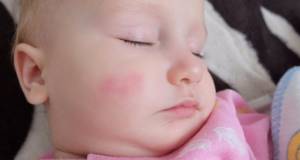
Low immunity of the skin, according to experts, can be the cause of such unpleasant phenomena as red spots that form in the chin area and on the wings of the nose in the late afternoon, which are accompanied by peeling. By morning they can disappear on their own and not bother you until the next evening. If the situation does not change over several weeks or even months, the doctor may suggest chronic liver and gallbladder disease, or reduced skin immunity.
If the spots are rough and flaky
Flaky spots on a child’s skin can occur at any time due to allergies, infectious diseases or diathesis.
The most common pathologies accompanied by the appearance of rough spots:
- contact dermatitis;
- eczema;
- versicolor or pityriasis versicolor;
- psoriasis (scaly lichen).
Red spots on a child's skin from dermatitis occur as a result of exposure to external irritants: extreme heat, cold, cosmetics, friction, alkali or acid.
The hands most often suffer, less often the legs, if there was direct contact with an aggressive environment. The skin is red, rough and rough to the touch. Treatment: exclude exposure to the irritant, smear the affected areas with a moisturizer. Pediatricians advise pouring 3-4 bay leaves into a glass of boiling water and adding the infusion to the baby’s bathing water to relieve itching.
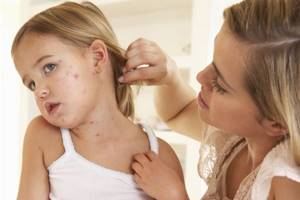
Red spots on a child's body can cause eczema, contact dermatitis, psoriasis and lichen.
Eczema is a complication of contact dermatitis. The rash appears mainly on the face: forehead, cheeks; these are red, scaly spots that cause unbearable itching. The treatment is the same as for the initial stage of the disease, plus hormonal ointments are prescribed.
Versicolor or pityriasis versicolor - this fungal disease is the result of vacationing in hot countries, close contact with an infected person or stray animal.
The spots are localized on the stomach, back, shoulders, chest and can be pink, yellow or brown. The peeling is strong and leaves marks on clothes and bedding. Therapy includes emollient and antifungal medications.
Psoriasis tends to be inherited. The disease is not contagious and appears as flaky and itchy red or pink spots. There are plaques on the head, hands, elbows, knees in the coccyx area.
The shape of the elements can be oval, round, ring-shaped, linear. Treatment is complex, including antihistamines, anti-inflammatory drugs, and physiotherapy.
Vitiligo
The most common cause of white spots on a child's skin is vitiligo (skin depigmentation). The disease develops as a result of the destruction of melanocytes, which are located in the thickness of the skin.
Typically, white spots on the skin are localized on the surface of the face, hands, and knees. However, they do not cause any discomfort to the child.
Among the causes of vitiligo are hereditary and autoimmune diseases, severe viral infections, dysfunction of the hypothalamus and pituitary gland, parasitic intoxications and others.
Nowadays, there is no way to completely cure this disease. For best results, it is important to start treatment as early as possible.
Diaper rash and prickly heat
Red spots on a child's body with heat rash can look very different. The photo with description clearly demonstrates this. Most common in children, heat rash is a skin irritation caused by excessive moisture.
Sweat does not have time to evaporate, remains on the skin and causes discomfort. Miliaria blisters are localized on the back, buttocks, neck, armpits, and other places with high humidity.
The main difference between a rash and the manifestations of other diseases is that it never appears in the facial area and is not accompanied by an inflammatory process. Children can only fall asleep in a cool, well-ventilated room.
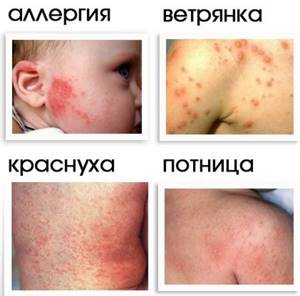
To get rid of the symptoms of prickly heat, it is necessary to eliminate the factors that cause pollution and waterlogging of the skin. If you provide good ventilation in the room and follow hygiene rules, the phenomenon will soon go away on its own. In advanced cases, body temperature may rise.
An allergic rash is extremely difficult to remove; it persists even after contact with the irritant has been eliminated.
Diaper rash (diaper dermatitis) is a complication of prickly heat, an infectious inflammation localized in the natural folds of the skin. The baby is capricious, sleeps poorly, cannot sit in one place - everything hurts and itches.
What are the types of pathologies
Red, pink, scaly spots on the face indicate various diseases.
- Psoriasis is a chronic disease of autoimmune origin. Dry spots appear on the face, elbows, knees and other parts of the body. The scales are easily scraped off, and a thermal film forms in their place. If you remove it, the wounds begin to bleed. Psoriasis is not contagious, exacerbation is replaced by remission.
- Lupus erythematosus is an autoimmune disease. It affects not only the skin, but also internal organs. Red rashes appear on the nose and cheeks, covered with bright, scaly plaques.
- Eczema – itchy reddish blemishes form on the face. The skin dries and cracks, and the scales themselves peel off. Due to severe itching, it is impossible to resist scratching.
- Ringworm is a fungal infection that can affect any part of the body, even the scalp. Ringworm is red or pink in color. It is characterized by severe itching and burning. There may be an increase in temperature and a deterioration in general health. This is a contagious disease, so until complete recovery it is necessary to limit contact with other people.
- Allergies are a common reaction of the body to irritants. Bright rashes form on the skin. In addition, there is lacrimation, mucus discharge from the nose, swelling, and cough. To get rid of spots, you need to avoid contact with irritants and take antihistamines.
Often, spots form during pregnancy. This is explained by hormonal imbalances in the body of women. Such rashes disappear on their own without treatment.
Pityriasis rosea
The worst type of infection to treat is infection from an animal; if the mother does not recognize the development of the pathological process in time, it will become chronic. As a result of complications, pathogenic fungi will begin to spread with the lymph flow throughout the body, affecting not only the skin.
Symptoms of the disease:
- slight increase in temperature;
- a sore throat;
- headache;
- the appearance of edema;
- different sizes of plaques and uneven edges;
- peeling of the skin.
When the scalp, including the scalp, is affected, bald patches appear in this area. Due to severe itching, the child scratches the skin, and bloody wounds form at the site of the spots.
Therapy for severe forms of the disease includes corticosteroid ointments and creams; itching and flaking are eliminated with products containing zinc. Wet spots are dried with iodine; in addition, the doctor may prescribe immunostimulants and multivitamins.
red rough spot on a child's face
I wrote the post in fits and starts for a couple of days, in my free time. Finally, I mastered it. It's worth it.
I will try to write in detail, because this is one of those cases when “seven nannies have a child without an eye” or, more precisely, the banal truth - the health of your child depends only on you...
So, the saga with our allergies (which began with an incomprehensible scream and red heels) has come to an end. We figured it out.
I was on some crazy diet for 1-1.5 months... All I had to do was do a blood test to determine allergens using the mast cell degranulation method
.
Where to begin…
Background. The problem with allergies arose for us after an incident with severe crying and redness of the feet
Immediately after the night in the hospital (I still don’t understand why the f... I allowed us to be taken away, we were just very scared, and the doctors at the ambulance were convincing post)
, we went to Allergomed for an appointment with an allergist.
At that time, we had red, rough areas on the left cheek, on the chest (where the tie is) and on the collar of the neck. It didn't look like a rash, just pinkish areas and rough skin. I noticed that after sleep, in the morning the redness was especially bright, but at the same time, after 1-2 hours they could turn pale and become invisible. I kept a food diary. I couldn't understand anything. I told the doctor all this.
The doctor cheerfully assured that yes, it’s all an allergy, don’t worry, both legs and cheeks and everything together - it happens. She gave us a sheet of food that we could eat, wrote down skin care and sent us off to rest until 4-5 months. We were then 2 months 3 weeks old.
Here are her appointments and a list of products
I spent a little time on this “wonderful” diet, where the basis of the diet is pork, which I disdain in everyday life, as the dirtiest meat in terms of a/b and other additives. And steel - some kind of cabbage, legumes, pasta and potatoes. Nothing has changed for us except my mood... and baby's gas pumps((((
I started going on a diet very quickly and began to quietly try something to eat. The picture hasn't changed.
After some time, after 1.5-2 weeks, the little ones started crying again and we saw how the feet became red and hot. They gave me fenistil out of fear. I started watching. My thoughts, of course, were racing like a squadron... It was scary, but I couldn’t understand anything, no matter how much I read on the internet or asked here. I racked my brains, tried to track down possible causes... Nothing worked. Then I began to analyze it and wrote a certain pattern on a piece of paper: I noticed that the baby first slumped, then her legs began to turn pink. Moreover, the more you cry, the pinker your legs. At different times of the day. Regardless of taking fenistil. Sometimes I would immediately calm down, not even crying, and my legs would turn pale. And sometimes I would cry a lot and my legs would turn pink to the knees... And then doubts began to creep in. At this time we were busy re-registering the voluntary health insurance policy and selecting a clinic for small children. Our policy was just ready and we went to the clinic on Kollontai Street. (your advertisement could be here). Nothing like the clinic, nearby, and most importantly, the specialists did not disappoint. We went to the pediatrician and told the story about the legs. Sitting next to me was a nurse who also works with their allergist. And so she, rolling her eyes, began to talk about the fact that in general it was very strange, manifestations such as we described with the legs were not typical for allergies. And it seems that she was with an allergist at an appointment when a family came with something similar. Since we were very worried about these attacks, and an appointment with their specialist was not soon, she dialed their allergist-immunologist in front of me and asked a question. The allergist confirmed that this was something completely out of the ordinary and the last thing she would think about was allergies.
The pediatrician decided to check the circulatory system for vascular issues (because the legs were turning red) and also the tummy - she prescribed 3 poop tests (coprogram, culture for dysbacteriosis with sensitivity to antibacterial drugs and culture for pathogens - Shilgella and Salmonella). At our request, she wrote a more serious diagnosis (angioedema is questionable, heart murmurs that were not there) so that the insurance company would approve (accordingly pay for) a visit to an allergist, cardiac ultrasound, physical therapist, who, in turn, should have meant massage, neurological procedures (I don’t remember if I wrote about the neurologist, but there my aunt correctly determined the tone, the tension in the neck).
Eventually. Heart - ok. The tummy is like everyone else, healthy lacto and bifido and some others are lowered, the evil stuff is present, but “no crime” according to the pediatrician.
And now we come to the most interesting thing - a trip to an allergist-immunologist (
the second time, but to another doctor, the cat consulted a nurse over the phone at a pediatrician’s appointment)..
A young girl, maybe my age. I listened carefully. She said that problems with legs for food are very rare. More like contact urticaria. But even that is in doubt. It was clear that she was analyzing what I was saying. And he doesn’t wait until I speak out, then nod, stick in a sheet with the diet and appointments, and say goodbye. She said that she remembers several children with such hives on their legs, and they had it seasonally - in those years (2007 and some other year) when the tree flowering factor coincided with the weather and a concentration of pollen was created in the city for several days.
And she directed us to donate blood... In response to my questions about the fact that blood for allergens is not informative at our age, she said that yes, it is not informative only if it is not studied by the method that she wrote about at the beginning of the post - mast cell degranulation. And for some reason only 2 laboratories do it in St. Petersburg, 21st century and invitro... (they, as I understand from the form of the results obtained, take the blood to the laboratory of City Children's Hospital No. 1)
I felt a glimmer of hope. The analysis is done for 14 days.
Passed 6.6., got 25.6 - a gift for my birthday: food allergies NOOOOOOOOOOOOOOOOOOOOOOOOOOOOOOOOOOOOOOOOOOOOOOOOOOOOOOOOOOOOOOOOOOOOOOOOOOOO
Checked:
eggs 11% (doubtful reaction +-, this means NO. Allergy from 19%, I think, I don’t remember)
milk 12% (same)
wheat 11%
chicken 11%
cat hair 9%
grass pollen 10%
The most interesting:
house dust mite 2 types: pteronymus 11% and a second one 9%
Here she noted that these percentages also logically mean that there was contact!
Accordingly, we have them in our house and it would be necessary to treat everything, wash it with Acaricides, and replace natural coverings and all kinds of bedding with artificial ones. This applies to fillers - down, feather, wool. This is exactly what my husband and I have 2 blankets from. That's why she woke up flushed, as she slept under our adult blankets with me on the bed!
Accordingly, there is no food allergy to anything. (it is clear that such things as red, citrus, chocolate, chemicals such as dyes and flavors are by default included in the forest and therefore have not been checked.
By the way, by trial and error, I figured out what the reaction was to in the case of hives in this post - to flavored ice cream. By that time, I had already tested ice cream and ate it once or 2 times a week. And then I came across something tinted. I missed something. Then I ate the usual, just milk without anything in a glass - again silence. Then - a glass of milk with vanilla - a little sprinkled with specks. Fenistil 7 drops, about 20 minutes passed. This is where everything came together.
So, all the chemicals, including flavored bagged teas (I’ll voice them just in case, as it’s not always clear by default), which I didn’t really respect anyway, and other products on this topic are a miss, but not as much as I used to, like once a month, it’s okay, but in general, don’t even touch a child’s skin if your hands, for example, are covered in colored ice cream. And I hope that all this will remain the same after the end of the Civil War. This is a good habit.
Continuing with the thought of skin and reactions to natural fillers:
The osteopath, at her first appointment, also noted that she had doubts about allergies. My daughter’s liver is not allergic (according to her, because she has a lot of allergy sufferers at her appointments), and from her appearance she carefully stated that it doesn’t look like an allergy, although she is not an allergist, however, again, she relies on those many children who come to her with allergies. And it was she who first asked me what fabrics and fillings were next to the child. Mother of three children. After 2 allergists and 2 pediatricians, 2 neurologists (okay, they seem to be off topic) - aptly, with one targeted question, I saw the root of the evil.... An osteopath...
And I removed the duvets from our bed. I put my daughter under her blanket and a cotton blanket. It’s not as comfortable as under a big blanket; you always have to check how it’s covered. But these are minor things. In the evening we bathed in emolium milk... In the morning the skin was without a single spot. The roughness went away in a couple of days.
Bravo..
I'm both happy and a little shocked by everything. From doctors...
Now, exactly since my birthday, I eat everything.
And nothing happens
ugh three times.
What happened to the legs?
Nothing. An ingenious invention of medicine is the term VSG (vegetative-vascular dystonia).
That is, everything that comes from the nervous system and does not fit into the standard parameters of the work of the National Assembly according to the WHO standard.
The allergist explained this. Especially considering my husband and I have WASH - both of us, at a minimum, have cold feet and hands from time to time (not related to heat or cold). But what can we say, we all have WASH to one degree or another. And even more so for the baby... the NS is not set up yet.
From strong crying, or from trying to push when there was colic, or now, when there is gas, or even just from a bad mood and whims. He starts crying, his face turns red, and because of the immaturity of the vascular system, his legs go there. You just need to not make her cry too much, calm her down in time and by any means necessary. Just like any other child at any age (my opinion).
Something like this.
The moral of this story is this: there are a lot of people in white coats... and they all love money.
And loving our children is our task. So search, search and search again: doctors, solutions, treatment, reasons. Double check everyone. And listen to your intuition. I hope mine won't let me down.
Infectious diseases
Red spots on the skin of children in the form of a rash that spreads throughout the body and is accompanied by an increase in temperature are one of the clearest symptoms of infectious diseases.
Such diseases include:
- Rubella manifests itself as a profuse rash on the body, fever, sore throat, and enlarged lymph nodes.
- Measles is an acute infectious disease that is accompanied by high body temperature - up to 40C°. The rash lasts for 10 days and is very itchy.
- Chickenpox is the most common childhood infection. Symptoms are blisters all over the body, often on the oral mucosa, and high fever. Infection occurs in 100% of cases through contact with a sick child.
- Erythema is accompanied by severe redness of the skin as a result of dilation of capillaries due to abundant blood flow. A rash appears on the limbs and genitals, causing severe burning.
- Scarlet fever is different in that there are no rash elements in the area of the nasolabial triangle. In this case, there is an increase in lymph nodes, redness of the cheeks, and puffiness of the neck. The larynx becomes inflamed, bacteria mainly multiply in the nasopharynx.
- Roseola is characterized by transience and similarity of symptoms to many other pathologies. The disease appears suddenly and disappears just as quickly. The child’s body temperature often rises to 40°C and persists for 3 days. The patient loses his appetite, becomes irritable, and quickly gets tired.
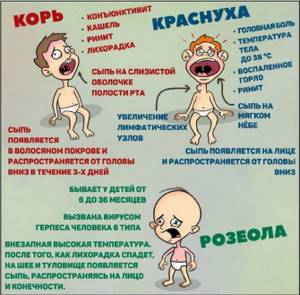
Treatment is aimed at relieving symptoms, lowering the temperature, relieving itching and preventing injury to the elements of the rash. Chickenpox and measles are treated with brilliant green to dry the wounds and prevent the spread of infection.
dry reddish spots on the skin of the baby.
When spots appear on the heels at any age, this indicates a sign of an unhealthy body, causing discomfort and unpleasant sensations. Heels may peel, itch, and hurt when walking. Similar manifestations often appear in people who have previously been exposed to long-term exposure to low temperatures on their heels. In addition, red heels appear in those who have increased skin sensitivity and wear uncomfortable shoes.
Sometimes redness of the heels indicates serious pathologies - diabetes, mycosis. To eliminate the problem, you should not carry out independent treatment, but consult a doctor. Rash refers to a broad medical concept. A large number of reasons lead to its appearance. Rashes are pathological elements on the skin and mucous membranes, differing in color and texture.
When white spots on the sole of the foot do not cause any discomfort, being only a cosmetic defect, they speak of the presence of vitiligo. It develops when the dermis loses its natural pigmentation due to changes in melanin. Then individual parts of the body lose their normal color, which leads to the appearance of white spots and variegation.
The factors for the development of vitiligo in the foot area have not been fully identified. Certain pathological processes, drug use, hereditary factors, and stress can provoke the appearance of white spots on the soles of the feet. Spots in the area of the feet can rise above the plane of the sole or be completely flat. Their colors range from pale pink to rich wine red. If the heel is red, a person may experience itching and peeling. Often, any change in skin pigmentation is the result of an imbalance, a disease of the body - allergic reactions, an unbalanced diet, vascular changes, skin diseases.
The factors that cause red spots on the feet are the following: The most common occurrences of rashes on the skin of children's feet are associated with allergic manifestations and inflammatory processes.
Allergic reactions include the following pathologies: Red spots on a child’s heel are formed due to viruses and infections. The atypical appearance of red dots on the heels may be due to an enterovirus infection. The symptoms are very similar to reovirus infection; abdominal pain, vomiting, diarrhea, and fever may also develop.
Both small reddish pimples and larger red pimples appear. The spots on the child's heel do not itch. Red heels can indicate the presence of a number of problems with a person’s health.
Diseases in this case do not always affect the limbs; some diseases of the internal organs are often reflected on the skin. Red spots on the feet may be a symptom of an allergic reaction. The reason may be the use of new cosmetics, medicines, or food products. Allergies also occur to fabric dyes and their composition. It is imperative to find the red heel factor by undergoing certain allergen tests in the hospital.
The danger of red rashes may lie in suddenly formed spots on the soles. Symptoms may indicate the presence of vasculitis, where blood vessels become inflamed. With constant manifestations of bruises on the limbs, red spots in the heels, this may indicate a pathology of the circulatory system. Due to blood clotting disorders, lack of vitamins, and use of medications, blood vessels become fragile. Blue spots on the limbs appear as a result of:
This leads to weakening of the walls of blood vessels; the blood that protrudes from them is visible under the skin. Red spots in the heel area can appear due to chickenpox and measles. With these pathologies, holes with a small diameter appear.
The rash can spread throughout the body. A person faces a number of signs: The most common factor in the development of foot allergies is incorrectly selected cosmetics or an individual reaction to procedures.
As a result, red dots on the heels spread throughout the sole. Itching occurs, which causes discomfort. The appearance of red scaly spots on the heels is observed due to a viral infection. The pathology manifests itself as itching, burning, and unpleasant odor. Similar symptoms are characteristic of mycosis. The disease manifests itself in small spots, with the possible formation of blisters. If you have a fungal infection of your heels, you need to visit a dermatologist and prescribe antifungal medications.
Education refers to a benign neoplasm. In pathology, the vessels are intertwined with each other, forming a huge red zone. Hemangioma does not cause discomfort. It is recommended to remove the red tumor surgically. Psoriasis is a chronic autoimmune disease that affects the skin. An ordinary scratch or injury can lead to pathology.
A characteristic symptom is red rashes on the heels in the form of plaques, flaky and accompanied by itching. The pathology is not contagious, but it is not curable.
Scabies is an infectious pathology that is quickly transmitted by the pathogen, which is the scabies mite. The main sign of the disease is red dots on the leg. The red spot on the heel causes severe itching, intensifying at night. The pathology has a congenital and acquired course.
Diagnosis and treatment of pathology is carried out by an endocrinologist. The formations have a symmetrical appearance and spots form on the feet, including the heels. The feet take on a dark cherry color. Redness of the heel and pain in this area appear as a result of incorrectly selected shoes, wearing socks, or synthetic tights. The spots on the heels may be dry and itchy. Basically, this manifestation disappears on its own after a day.
Heels also become red due to the influence of sunlight, heat, cold, and water. A person’s heel itches, the sole becomes hot, and he may feel feverish. When scratching the heel, the lesion will become even larger, changing the skin color from bright to dark. Regardless of the development factors, redness on the heels must be treated.
It is better to carry out therapy under the supervision of a specialist who knows the peculiarities of the occurrence of a particular pathology. At home, you can try to eliminate red spots on your heels using traditional methods. If the cause is a fungal disease, make a bath of 0.5 liters of water, sea salt and a tablespoon of soda. Dilute the ingredients in warm water and steam your heels in the bath, leaving for 20 minutes.
Carry out the manipulation for a week. If psoriasis is present, a compress is applied to relieve the inflammatory process and minimize the space of the formations. Finely chop a medium onion and 5 cloves of garlic to obtain juice. The mixture is applied for 2 minutes. For allergies, antihistamines are used. With this symptom, people often consult a dermatologist or surgeon.
After the required studies have been completed, a referral to a specialist who specializes in treatment may be given, who will prescribe the correct treatment. In treatment, prevention rules today play an important role. You need to pay more attention to the care of your heels and the general well-being of your body. In medicine, therapeutic foot massage is used, which not only relieves fatigue, but also treats diseases. The feet have biologically active zones responsible for human organs. Massaging the sole during hyperemia, if it hurts to step on the heel, should be done completely, and not certain active points of the foot.
In case of pain, redness of the feet, initially the soles of the feet warm up and warm up. Then walk barefoot on a special mat, stand on your toes, and take a warm foot bath. The foot is rubbed with stroking movements, then you need to press for about 7 seconds on the areas for which the active points are responsible, moving from each toe to the heel.
It is recommended to use traction - massaging each finger, tapping, moving from one leg to the other - using the edge of the palm, pinching. During the massage, painful points may be discovered. This means that not everything is normal in the relevant body for which they are responsible. Massage of these points needs to be done more carefully. The technique of influencing pain points is carried out by pressing with the thumb, alternating stops.
The entire procedure should not take less than a minute. With proper massage, heel pain should go away. The right and left feet are divided into 5 sections, lined with boundaries.
The appearance of spots on a child’s legs indicates the development of a pathological process in the body.
Photodermatosis
Or photodermatitis is an increased sensitivity to sunlight; children under 3 years of age are at risk.
The disease is characterized by the following manifestations:
- itchy rashes on exposed skin;
- peeling of the skin (chronic form of the disease);
- redness of the affected area;
- rashes in the form of nodules, blisters;
- pigmentation after prolonged exposure to ultraviolet radiation.
Symptoms also appear, together with the signs described above, that are characteristic exclusively of photodermatitis:
- lowering blood pressure;
- heat;
- sneezing and runny nose;
- suffocation;
- lacrimation;
- swelling of the mucous membranes.
If, after being in the sun, the body becomes covered with pink spots with blisters, the child should be taken indoors, the skin should be rinsed with clean water and an antihistamine should be given.
The best prevention is to protect the child from ultraviolet radiation, not just from direct sunlight. Even in the shade, he should wear a hat, long sleeves, mainly made of natural fabrics. For treatment, antiseptic drugs, zinc-based ointments, antihistamines, and anti-inflammatory creams are prescribed.
Hand-foot-mouth syndrome
(from the English name Hand-Foot-and-Mouth Disease, HFMD), or enteroviral vesicular stomatitis with exanthema.
Pathogen: enteroviruses.
Mode of transmission: fecal-oral and airborne. The virus is transmitted from person to person through communication, conversation, and the use of common household items (dishes, toys, bed, etc.).
Immunity: after illness - lifelong.
Incubation period: from 2 days to 3 weeks, on average about 7 days. Infectious period: from the onset of the disease.
Manifestations: first the temperature rises and stomatitis begins: rashes on the oral mucosa, pain when eating, excessive salivation. The temperature lasts 3-5 days, often accompanied by diarrhea, and in some cases a runny nose and cough. On the second or third day of illness, a rash appears in the form of single blisters or small spots. The name of the disease comes from the location of the rash: it is located on the hands, feet and around the mouth. The rash lasts 3-7 days, after which it disappears without a trace.
Treatment: there is no specific treatment; symptomatic drugs are used to reduce fever and relieve pain during stomatitis. The disease goes away on its own; complications are possible only if a bacterial or fungal infection occurs in the oral cavity.
It is not easy to make a diagnosis of enteroviral vesicular stomatitis, because... The rash does not appear immediately and is very often regarded as a manifestation of an allergy.
Important: despite the active use of various painkillers in the treatment of stomatitis, the first few days it may be very painful for a child to eat. In such cases, it is good to use the most liquid food possible (milk, dairy products, milkshakes, baby food for babies, soups, etc.) and give it through a straw. Be sure to monitor the temperature of the food: it should not be cold or too hot - only warm.
Dermatitis
Dermatitis is considered to be a group of inflammatory reactions of the skin that develop due to exposure to external or internal irritants. Causes of appearance in childhood: frequent infectious diseases, genetic predisposition, dysbiosis, use of certain medications.
There are several main types of dermatitis:
- atopic;
- contact;
- seborrheic;
- diaper
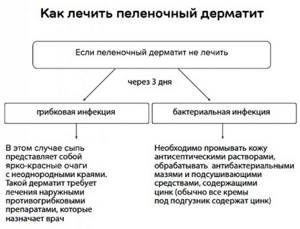
Each pathological process is accompanied by characteristic redness of the skin, peeling, and abrasions. Vesicles, pimples, and blisters appear on the face, groin, buttocks, and genitals. Complications manifest themselves in the form of swelling, itching, pain in the affected areas of the skin, pustules form, the skin on the face around the mouth, hands and elbows becomes very dry.
How to get rid of red spots on your face
It is not recommended to carry out treatment until the cause of the redness is determined - even if the chosen methods get rid of unpleasant manifestations, they will only mask the problem, but will not solve it. The action plan should be drawn up together with the doctor, since it depends on the diagnosis:
- For allergies, only oral antihistamines can help get rid of redness.
- If the spots are the result of skin diseases (lichen, psoriasis), topical use of tetracycline and erythromycin is necessary.
- When acne appears and other skin inflammations, antiseptics and hormonal ointments are used.
- Antimycotics help against fungal infections.
To eliminate red areas caused by skin problems, you can use topical agents in ointment format. If the spots are external manifestations of diseases of the internal organs, such therapy does not make sense. The most effective drugs:
- Tetracycline ointment will help eliminate flaky areas with redness. The drug has a bacteriostatic effect and is an antibiotic, so its effect should be short-term. Not effective against fungi.
- Acyclovir is mainly used on raised spots that are associated with a viral infection. The drug works quickly, so the course of treatment lasts up to 5 days.
- Hydrocortisone ointment is often used on the affected area of skin under the eyes: it is a glucocorticosteroid that relieves inflammation, itching and dryness. Helps with neurodermatitis and other skin diseases.
We invite you to familiarize yourself with Asian cosmetics: truth and myths
If doctors call ointments heavy artillery, then creams are used more in case of inflammation or problems with skin regeneration. Specialists can prescribe retinoid agents that soothe, bactericidal or stimulate tissue repair:
- Lorinden-S. A cream based on glucocorticosteroids, works as an antiallergic agent, helps with manifestations of neurodermatitis on the face, erythema, lichen, herpes. If the face begins to become covered with plaques that itch, it can act as a blocker to their further spread.
- Cynovitis. Budget cream-gel with bactericidal properties. Mainly recommended for inflamed rashes, but can also help with skin diseases.
- Clenzit is a retinoid product that is not recommended for dermatitis, but helps to cope with redness that is associated with inflammation.
Special salon and home techniques can also be used to eliminate areas of redness, but they need to be selected together with a cosmetologist. Mainly used:
- Cryomassage is the effect of cold air on the skin, which helps get rid of red vascular formations.
- Acid peels help eliminate flaky spots.
- Manual or machine massage using a vitamin complex improves the general condition of the skin.
Blood and vascular pathologies
Vascular red spots on a child’s body, according to the photo with description, can be of different sizes and colors. Rashes in these diseases are provoked by hemorrhages in the skin and spread throughout the body, otherwise they are called hemorrhagic.
Causes:
- disruption of the functioning of platelets involved in the process of blood clotting;
- poor vascular permeability.
Typically, vascular spots appear in a child immediately after birth or are diagnosed in the first days of life. The peculiarity of this rash is that it is not palpable, does not disappear when pressed, and does not turn pale. The color of the formations can be very different, from red and blue to dirty gray. It disappears completely after 3 weeks.
Allergy
Red spots in a child from food allergies most often appear around the mouth and on the cheeks. This protective reaction of the body is provoked by certain medications.
The distinctive signs of allergies from other pathological processes are the good general condition of the child. As a rule, the patient is only concerned about itching, there is no high temperature, appetite does not disappear, and drowsiness is not observed.
Often there is lacrimation, a profuse runny nose, and the rashes are clearly visible, prominent, and bright. In addition to skin reactions, rhinitis and conjunctivitis develop. Antiallergic drugs and medications that soothe itching help eliminate symptoms.
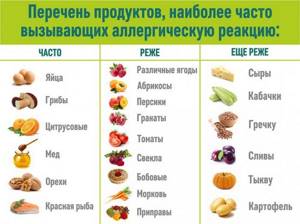
Nuts, fish, citrus fruits, chocolate, mayonnaise, mushrooms, milk, pastry and other allergens are excluded from the diet. It is recommended to consume butter, sunflower, olive oil, fresh cucumbers, white bread, dairy products, and beef.
In what cases is a visit to the doctor required?
You should seek help if the rash does not go away within 7-10 days, and the child has a persistent high fever. Decreased appetite and causeless irritability should attract the attention of parents and specialists. A dermatologist will help when the rash is accompanied by bleeding, burning and tingling.
It is necessary to urgently call an ambulance when black formations begin to appear along with red spots. A medical examination is also required when the whole family falls ill at once, the patient complains of chest pain, or anaphylactic shock occurs (loss of consciousness, difficulty breathing).
What can you apply to stains and in what cases?
Systemic therapy is carried out using antihistamines in the form of tablets, syrups, ointments for external use, and gels.
Allergic spots are eliminated using the following drugs:
- Fenistil;
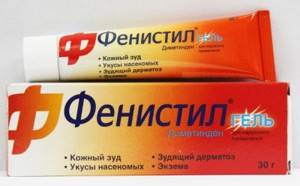
- Gestan;
- cream for sensitive skin "La-Cri".
They have an anti-inflammatory, healing and soothing effect. If you are allergic to cold, you should lubricate your skin with olive oil before each time you go outside. Red spots, without fear of side effects, can be treated with Depanthenol, Bepanten, Panthenol, or regular baby cream with chamomile. These products promote rapid healing of wounds and cracks.
Zinc ointment helps well with chickenpox, eczema, diaper rash, bedsores, and dermatitis. This is one of the most accessible means for use in dermatological pathologies. The active ingredients accelerate the healing process and reduce the symptoms.
Traditional methods of treatment
Traditional medicine is used as an auxiliary method to relieve symptoms and diseases accompanied by rashes.
The following recipes will help you cope with allergies:
- eating honeycomb (in the absence of an allergy to the product);
- crushed eggshells to a powder, mix with lemon juice, take ½ tsp. per day until symptoms relieve;
- Activated carbon 1-2 tablets per day will help relieve intoxication of the body;
- Applying boiled cabbage leaves for 2 hours will relieve itching;
- a bath with wormwood oil has an excellent healing effect;
- red spots disappear faster if they are treated with sea buckthorn oil.
A decoction of chamomile will help restore the healthy appearance of your skin - 1 teaspoon of dry herb per glass of water. Boil, pour into molds and freeze; if you have allergies, wipe your skin with ice cubes - this will relieve irritation.
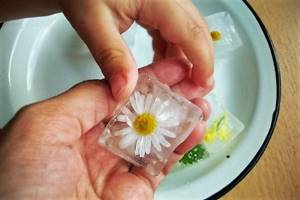
Pansies and wild rosemary herb are mixed in equal proportions - 2 tbsp. spoons, pour 1 liter. boiling water The broth is infused for 45-50 minutes, after which it is poured into the bathtub for bathing. Therapy is carried out until the rash completely disappears every day for 10 minutes.
Red spots on a child’s body (as can be seen from photographs of symptoms of various diseases) may indicate various malfunctions in the body or the presence of pathology.
It is impossible to protect children from everything: sunlight, wind, animals, infections, allergens and insects. It is important to strengthen the immune system, strengthen the baby, rationalize nutrition and, as prescribed by a doctor, give multivitamins as a preventive measure to improve health.


